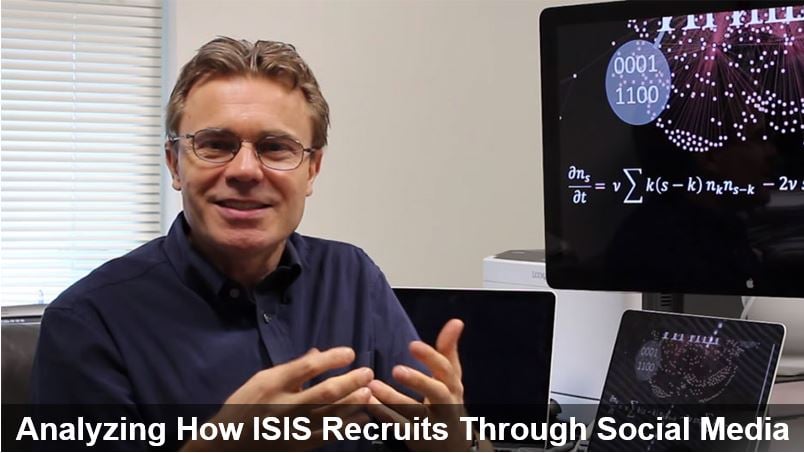The laws of physics can be used to study how ISIS terrorist support groups expand online, how terrorist behave, and create roadmaps to their activity which would help cyber police and other anti-terror watchdogs know when horrible things are about to happen.
Put simply, the laws of physics can allow us to be one step ahead of ISIS terrorists, says a team of researchers led by the University of Miami.
The scientists, who identified and analyzed 196 pro-ISIS groups operating from January to August 2015, found that even though the majority of the 108,000+ individual members of these self-organised groups had probably never met, they had a remarkable ability to adapt and extend their online longevity, grow in size and numbers, reincarnate rapidly after being shut down – and inspire ‘lone-wolves’ without any history of extremist activity or sympathies to carry out horrific attacks, like the mass shooting at a gay nightclub in Orlando in Florida earlier this week – a ‘lone-wolf’ killed nearly 50 people in a horrific shooting spree.
![]() (Large left graph) Empirical size variation of pro-ISIS aggregates. Shark-fin shapes of all sizes emerge with shutdowns that are not closely correlated. (Smaller right graphs) Similar results are predicted by the researchers’ theoretical model, irrespective of whether they consider the model’s initial or steady-state dynamics. (Image: science.sciencemag.org)
(Large left graph) Empirical size variation of pro-ISIS aggregates. Shark-fin shapes of all sizes emerge with shutdowns that are not closely correlated. (Smaller right graphs) Similar results are predicted by the researchers’ theoretical model, irrespective of whether they consider the model’s initial or steady-state dynamics. (Image: science.sciencemag.org)
Neil Johnson, a physicist at Miami University’s College of Arts and Sciences, and colleagues literally analyzed second-by-second records of online pro-ISIS movements during the first eight months of last year.
Like watching crystals forming
Dr. Johnson, who heads up a new inter-disciplinary research group in Complexity – at the University’s Department of Physics – looking at collective behavior and emergent properties in a wide range of real-world Complex Systems, said:
“It was like watching crystals forming. We were able to see how people were materializing around certain social groups; they were discussing and sharing information – all in real-time.”
Dr. Johnson says the laws of physics can also be used to study the collective behaviour of people, and not just particles.
“The question is,” he continued “can there be a signal of how people are coming collectively together to do something without a proper system in place?”
According to a paper that Dr. Johnson and colleagues published in the academic journal Science (citation below), the answer is ‘Yes!’
 The researchers studied and analysed the connection and communication of pro-ISIS groups in online social media websites, such as the one on Russia-based VKontakte, Europe’s biggest online social networking service. (Image: new.miami.edu)
The researchers studied and analysed the connection and communication of pro-ISIS groups in online social media websites, such as the one on Russia-based VKontakte, Europe’s biggest online social networking service. (Image: new.miami.edu)
The team generalized a mathematical equation – an algorithm – that is commonly used in chemistry and physics to the development and growth of ad hoc pro-ISIS groups. The researchers witnessed the daily interactions that drove online support for the ‘aggregates’ (groups) and how they blended and coalesced prior to the onset of real-world campaigns.
Dr. Johnson and colleagues suggest that by focusing just on these relatively few groups of dedicated followers – with individuals who discuss operational details such as avoiding drone strikes and routes for financing – cyber police and other anti-terrorist agencies could monitor their buildup and transitions and prevent any onset of a burst of violence before it starts.
Remove the guess work
Dr. Johnson said:
“This removes the guess work. With that roadmap, law enforcement can better navigate what is going on, who is doing what, while state security agencies can better monitor what might be developing.”
“So the message is: Find the aggregates—or at least a representative portion of them—and you have your hand on the pulse of the entire organization, in a way that you never could if you were to sift through the millions of Internet users and track specific individuals, or specific hashtags.”
While the authors focused on the ecology of collective behaviour, rather than single individuals, they say their roadmap could eventually help law enforcement officials track people like Omar Mateen, who killed 49 people and wounded 53 others at Orlando’s Pulse nightclub during the early hours of last Sunday – Mateen claimed allegiance to ISIS.
Mateen, who was born in New York and lived in Florida, was a lone actor who had become radicalized online.
 The extreme organisations that Dr. Johnson and colleagues were interested in were, for example ISIS, which somehow manages to maintain remarkable support across the world. (Image: news.miami.edu)
The extreme organisations that Dr. Johnson and colleagues were interested in were, for example ISIS, which somehow manages to maintain remarkable support across the world. (Image: news.miami.edu)
Lone wolves not alone for long
Dr. Johnson said:
“Our research suggests that any online ‘lone wolf’ actor will only truly be alone for short periods of time. As a result of the coalescence process that we observe in the online activity, any such lone wolf was either recently in an aggregate or will soon be in another one.”
“With time, we would be able to track the trajectories of individuals through this ecology of aggregates.”
In this study, the researchers collected and analyzed data on pro-ISIS groups on VKontakte, a social networking service based in Russia, the largest of its kind in Europe. It has over 350 million users who communicate in several different languages.
The authors chose sites in VKontakte because they survive for considerably longer than on Facebook before being shut down.
They started off their search for pro-ISIS online chatter manually, identifying specific social media hashtags in a number of different languages, which they used as ‘signals’ to track down the more serious groups.
Co-author, Dr. Stefa, Wuchty, Associate Professor at Miami University’s College of Arts & Sciences, Department of Computer Science, compared the hashtag search to throwing a stone in a pond, watching the ripples, and following each one carefully.
The hashtags took them to online groups, and the data was fed into a software system that mounted the search – the results were repeated again and again until the chase led back to groups that had been previously traced in the system.
 Some pro-ISIS websites manage to get lone-wolf terrorists to carry out horrific attacks. Omar Mateen, born in New York, killed 49 people and injured another fifty at a gay nightclub in Orlando, Florida.
Some pro-ISIS websites manage to get lone-wolf terrorists to carry out horrific attacks. Omar Mateen, born in New York, killed 49 people and injured another fifty at a gay nightclub in Orlando, Florida.
Mathematical equation helps predict horrific events
The algorithm (mathematical equation) that the team borrowed from physics and chemistry illustrated the fluctuation of online groups and pointed to possible predictions, i.e. it really seemed possible to forecast what some of them were going to do next.
Dr. Johnson said:
“The mathematics perfectly describes what we saw in real-time—how big and quickly these online groups grew and how quickly they were shut down by agencies or other monitoring groups.”
As anti-terror entities, including the cyber police, got better at tracking down the groups and shutting them down, Dr. Johnson and colleagues witnessed those groups re-invent themselves – reincarnate – by changing their identities and names, or simply shutting themselves down and going quiet, like an aircraft in stealth mode, only to reappear later under a different identity.
Regarding social media groups, Dr. Johnson said:
“Much of the scientific community is focusing on different explanations as to why social media is so important, and I think we found research that presents a kind of crystallization method, looking at the dynamics of these groups and how they crystalize, appear, and morph into other groups.”
 Social media websites are an effective way of creating terrorists in their target country’s homeland. While the authorities spend billions trying to stop terrorists from coming in from abroad, many of their own citizens are being brainwashed online.
Social media websites are an effective way of creating terrorists in their target country’s homeland. While the authorities spend billions trying to stop terrorists from coming in from abroad, many of their own citizens are being brainwashed online.
Dr. Johnson wrote about this latest research in the academic blog The Conversation – ‘Disrupting Pro-ISIS Online ‘Ecosystems’ Could Help Thwart Real-World Terrorism’.
Dr. Johnson and his colleagues’ quest to distinguish casual chatter from dedicated and serious pro-ISIS support started largely by coincidence two years ago while he was working on a grant from the U.S. Intelligence Advanced Research Projects Activity to create a model for predicting mass protest or unrest based on activity online. A grant is money awarded for a purpose or project.
Just as the grant was nearing its end, ISIS emerged on the world stage in a big way, becoming a familiar and widely-feared household name after beheading one and then more journalists from the USA and UK.
Miami native Steven Sotloff, the second journalist that the ISIS terrorists executed, had ties to the University of Miami. To honor their son’s work overseas, his parents established the 2Lives: Steven Joel Sotloff Memorial Foundation, which awarded its first Steven Joel Sotloff Memorial Endowed Scholarship to a student at the University of Miami’s School of Communication. A scholarship is a form of financial assistance to academically gifted people with financial needs so that they can continue studying.
Laws of physics used at @umcas to analyze how #ISIS recruits through social media https://t.co/S6127IbSPH pic.twitter.com/X4KnKgr3wi
— University of Miami (@univmiami) 18 June 2016
In an Abstract which describes the main paper in the journal Science, the researchers wrote:
“Examining longitudinal records of online activity, we uncovered an ecology evolving on a daily time scale that drives online support, and we provide a mathematical theory that describes it.”
“The ecology features self-organized aggregates (ad hoc groups formed via linkage to a Facebook page or analog) that proliferate preceding the onset of recent real-world campaigns and adopt novel adaptive mechanisms to enhance their survival. One of the predictions is that development of large, potentially potent pro-ISIS aggregates can be thwarted by targeting smaller ones.”
Citation: “New online ecology of adversarial aggregates: ISIS and beyond,” N. F. Johnson, M. Zheng, Y. Vorobyeva, A. Gabriel, H. Qi, N. Velasquez, P. Manrique and D. Johnson, E. Science Vol. 352, Issue 6292, pp. 1459-1463. 17 June 2016. DOI: 10.1126/science.aaf0675.
Video – How ISIS recruits online
In this video, Dr. Johnson talks about the latest study and how ISIS and other terrorist and protest organizations pull in new recruits.

